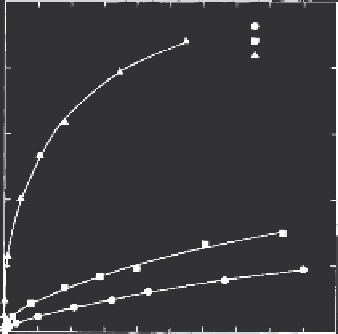Agriculture Reference
In-Depth Information
we designated earlier as those sites of strong kinetic influence due to their
large values of κ
1
and κ
2
. As the contribution of type 2 sites increases (or
F
decreases), the shape of the BTCs becomes increasingly less kinetic with sig-
nificant decreases in the amount of solute retention.
6.3 Experimental Data on Retention
The second-order model (SOM) was applied by Selim and Amacher (1988)
and Amacher and Selim (1994) to describe batch and miscible displace-
ment data sets for Cr(VI) retention and transport in three different soils.
Furthermore, they attempted, whenever possible, to utilize parameters that
were either independently measured or estimated by indirect means. The
parameters that were estimated included the adsorption maximum
S
max
, the
fraction of sites
F
, and the kinetic rate coefficients associated with the revers-
ible and irreversible mechanisms.
Retention data sets for Cr(VI) by three soils (Cecil, Olivier, and Windsor soils)
after 336 h of reaction (Figure 6.11) were used to arrive at independent estimates
of
S
max
and
F
. Specifically, the two-site Langmuir equation (6.12) was used to
describe Cr(VI) retention results using a nonlinear, least-squares, parameter-
optimization scheme. It was assumed that the reactions between Cr(VI) in solu-
tion and the two types of sites had attained equilibrium in 336 h even though
small amounts of Cr(VI) were still being retained by the soil. The continuing
1000
Olivier
Windsor
Cecil
800
600
400
200
0
0 0406080
100 120 140
160 180 200
C, mg/L
FIGURE 6.11
Two-site Langmuir sorption curves for Cr(VI) retention by Olivier, Windsor, and Cecil soils
after 336 h of reaction. (From H. M. Selim and M. C. Amacher. 1997.
Reactivity and Transport of
Heavy Metals in Soils
. Boca Raton, FL: CRC Press. With permission.)


Search WWH ::

Custom Search